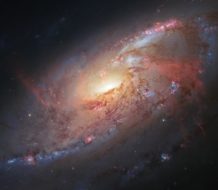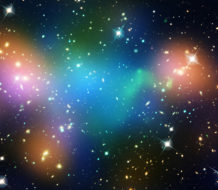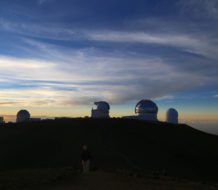The universe emerged from an iota of space-time 13.8 billion years ago. This initial state of extremely high temperature and density evolved into a vast, flat, and cold cosmos containing 100 billion galaxies and feeble microwaves left over from the big bang itself. How does the venerable religious tradition of Buddhism accommodate this modern scientific knowledge?
My personal perspective on this question stems from teaching Tibetan monks in northern India. Fifteen years ago the Dalai Lama was concerned that the monastic tradition was becoming outdated. In particular, he wanted math and science to be incorporated into the curriculum. So, almost every year, I travel to the foothills of the Himalaya, and in unadorned monastery classrooms, I teach cosmology to Buddhist monks and nuns ranging from young novitiates to senior Geshes. The monastics are remarkable students, technically naïve but conceptually sophisticated, with a fearless approach towards new knowledge and an unfamiliar subject.
The dynamism and respectfulness of the dialog between science and Buddhism is eye-opening for Americans who are used to the science-religions “wars,” or the wholesale rejection by some evangelical sects of the facts of evolution and an old universe. It is said that the Buddha advised his followers to test the truth of any statement just as a goldsmith would test the purity of gold, by the application logic and experimentation. This empirical mindset, and a corresponding lack of dogma, is a distinctive feature of Buddhism. The Dalai Lama epitomizes an open way of thinking about nature. In his 2005 book The Universe in a Single Atom, he has said, “If scientific analysis were conclusively to demonstrate certain claims in Buddhism to be false, then we must accept the findings of science and abandon those claims.”
To see how Buddhists might react to a scientific description of the universe, it’s worth summarizing the traditions they encounter in their training.
The cosmologies that became part of Buddhism were pre-Copernican world systems with a stationary, flat Earth at the center of the system. Both were developed in India and later translated into Tibetan. The Abhidharma system was expounded by the monk and philosopher Vasubhandu in the fourth century C.E. and the core text of the Kalachakra system was adopted by Tibetan Buddhists in the eleventh century. Both systems center on mandala or concentric circles, but it’s important to recognize that they are allegorical rather than representational. The systems have nested geographical circles centered on the sacred site Mount Meru and the arrangement is often compared to the human body, so these cosmologies provide a means for contemplating the connection between our bodies and the greater universe. The Kalachakra system involves nested wheels of time and is a different way to connect the universe with human existence.
At the beginning of the cosmology workshops I teach in India, I ask the monks to draw “the universe,” and roughly half of them generate a pre-Copernican view; many of the rest have encountered some astronomy and they typically draw a single large galaxy filled with stars. Buddhist scholars recognize these cosmologies as symbolic, and the Dalai Lama has said that Buddhism should abandon many aspects of the Abhidharma cosmology, in particular.
Even if Buddhist monks and scholars do not take the geographic descriptions of these traditions literally, the world systems they describe are surprisingly consonant with the modern scientific view of the cosmos. The one-world core of these ancient cosmological models extends 90 million kilometers from Mount Meru, roughly equivalent to the Earth-Sun distance. This is nested within a small system of a thousand worlds, which is in turn nested within a medium system of a million worlds. The largest grouping is referred to as a trichilicosm, with a billion worlds. This is within an order of magnitude of current estimates of the number of habitable planets in the Milky Way galaxy, based on data from NASA’s Kepler satellite. It is striking that this prodigious vision emerged from the Indian subcontinent at a time when cultures in China, Greece, and the Middle East could only grasp a cosmology centered on one world, the Earth.
Buddhism discusses a continuum of time. Just as a sentient being is born, dies, and is reborn, so a universe also transmigrates. The period of time between the creation and recreation of a universe is called a kalpa, from an ancient Hindu text that passed into the Buddhist tradition, it is specified as 4.32 billion years. Intriguingly, this is very close to the age of the Earth. The Buddha supposedly used evocative analogies to convey this huge span of time. In one, there is a mountain made of granite that’s 10 miles wide at the base. A dove flies past and brushes the mountain with its wing once a year; a kalpa is the time it would take to fully erode the mountain. The largest timespan in Buddhist cosmology is the entire life cycle of the universe, a great kalpa, or 1.32 trillion years. It’s a remarkable coincidence that this is similar to the span of the physical universe before the lowest mass dwarf stars run out of nuclear fuel and the cosmos goes dark.
Time and space are infinite in Buddhist tradition. This is also consistent with the best information we have on the physical universe. The big bang model involves faster than light expansion early in the history of the universe, so there are regions of space that have not yet become visible to our telescopes. Space-time is flat and it could be infinite. While the big bang posits an origin event 13.8 billion years ago, there is speculation that the universe arose from quantum fluctuations of the vacuum, and the eternal inflation scenario imagines and endless process of universes being created and destroyed.
It’s important not to force the analogies between modern cosmology and Buddhist cosmology. While “space particles” in the Kalachakra cosmology provide the link between cycles of creation and dissolution, it’s a stretch to associate these with the quantum vacuum states in modern cosmology. The premises of these world systems are quite different. Science understands all phenomena in terms of the evolution of matter and energy. Living creatures are complex and poorly understood and are not part of this model. Buddhism, by contrast, is life-centric. Buddhism holds that the Earth and the universe are the domain of sentient beings, and they are constructed from the common karma of the sentient beings themselves. The Buddhist perspective on the scientific descriptions of the universe is that they are seriously incomplete.
More broadly, the materialist premise of science limits its explanatory power. Science cannot claim to represent the totality of reality. So a Buddhist can accept the physical description of the universe and its evolution offered by modern cosmology, and still be confident that they don’t need science to affirm the validity or efficacy of their practices. The Middle Way philosophy of Buddhism allows a potential conflict to be avoided. Just because science hasn’t demonstrated something does not mean science has disproven it; absence of proof is not evidence of disproof.
The dialog between science and Buddhism is important because it allows the supple Buddhist philosophy to incorporate insights of cosmological observations and theories over the past century. But it’s also works in the other direction, encouraging humility among scientists who believe that they are deriving universal truths.
A pragmatic view of science is that it provides a set of tools for helping humans to understand their world. Most scientists accept an incremental view of their endeavor, thinking that they are building knowledge on what others have done before, moving inexorably towards an ultimate view of reality. But scientists often go beyond this to believe that things in the universe have intrinsic properties, that they exist absolutely and independent of each other and independent of observers. This is the fallacy of reification. The success of their enterprise leads many scientists to over-invest in the concept of truth.
To a Buddhist, this is wrong-headed. Things do not have an intrinsic, self-contained existence. Ultimate reality is emptiness. This is why the Buddha purportedly refused to answer questions like “Are the self and the universe transient?” or “Are the self and the universe eternal?”
Questions like this are routinely asked by a new generation of Buddhist monastics. In a classroom at the edge of the roof of the world, monks and nuns fully engage the latest research on cosmology. They act out the unification of the four fundamental forces in the big bang. They scatter poker chips on the floor and move them painstakingly one by one to mimic the way gravity sculpted galaxies into large scale structures. They create timelines of events in the history of the universe across the floor and use their formal debating skills to argue about the ordering, until the air is filled with the sounds of hand slaps and laughter. At this meeting of East and West, at this nexus of science and religion, there is joy of science and a lightness of being.
Discussion Questions
- Is it important for major world religions like Buddhism to accommodate what we have learned about the universe through astronomy, and if so, why?
- How does Buddhism describe time and space, and how does it differ from the way we understand time and space through physics and cosmology?
- How does the status of humans in the universe differ between a Buddhist and a cosmological perspective?
Discussion Summary
The question “What is a Buddhist Perspective on Scientific Discoveries about the Nature of the Universe?” generated some interesting discussion. It was pointed out that Buddhism is a complex religion with antecedents in Hindu thought, and that His Holiness the Dalai Lama espouses particular strands of Buddhist philosophy and not others. The Dalai Lama’s ideas naturally have great weight in the tight knit Tibetan monastic community. There is a larger debate among Buddhist scholars about ideas that relate to cosmology, such as the extent of time and space.
An area where Buddhism and science clearly part company is on the idea of rebirth. The cycle of rebirth that can only be ended with rigorous spiritual practice is not an idea that has traction among scientists. To even consider reincarnation critically, it’s important to say what it is not. Reincarnation is not a person having lived huge numbers of prior lives, usually as an animal, where when they die they will return as an animal or a human if they are lucky. Transmigration of the soul is not a Buddhist concept. There is not a permanent consciousness that moves from life to life. Rather, the dominant concept is karma, best translated from Sanskrit as “action.” Buddhists see karma as a universal chain reaction of cause and effect, a kind of moral law. There are good or bad mental and spiritual actions and the energy implied by these actions changes form but it not created or destroyed. In this sense karma is like a law of conservation of moral energy.
The Buddha’s thoughts on the relationship between karma, causality, and rebirth are set out in the twelve links of dependent origination. The moral cosmos in Buddhism has ten realms of being, with Buddha at the top and depraved or hellish beings at the bottom. By mental and spiritual actions a person and ascend or descend within this set of realms. Consciousness is a continual birth and death of mind states, and rebirth is the persistence of this process. Even if this is much more subtle than the “cartoonish” version of reincarnation mentioned earlier, it is difficult to relate it to any Western scientific models of mind.
Another profound concept that all humans wrestle with is reality. In simple terms, Buddhists see the material world as illusory. Our sense of reality is a form of projection, a denial of the ultimate emptiness of matter. A thread in the discussion addressed this issue. I pointed out that the stereotype of physicists as materialists is misguided, since quantum theory points to the evanescence of matter and the contingent nature of reality. Physicists can do reliable and precise calculations of microscopic quantities, so they have mostly chosen to ignore the deep philosophical issues raised by phenomena like entanglement and action at a distance. Neither Buddhists nor physicists have a firm grip on reality, but the latter are more likely to think they do!
A final area where Buddhists and scientists may not agree is in the status of humans in a vast, ancient universe. Buddhist philosophy is anthropocentric in terms of human importance in the chain of being, and our agency over the cosmic energy of karma. In modern cosmology, humans are unusual only in terms of their ability to comprehend the universe (to some degree). As biological entities they are unlikely to be unique or to have any special status in a universe that has likely resulted in many biological experiments, some of which may have produced creature much more impressive than us.
The results of the discussion and these perspectives on biology and reality suggest several new Big Questions.
New Big Questions:
- If biology exists in a largely uncaring universe, what is the role and nature of karma?
- How closely aligned are Buddhist and scientific concepts of reality?












What a fascinating job you have, Chris! I know the Dalai Lama takes a personal interest in scientific matters and has often stated that if science were to disprove some Buddhist belief then it is the belief that would have to go. However, the core teachings are probably not falsifiable so he’s on fairly safe ground.
Before addressing the discussion questions it’s worth remembering that the Dalai Lama’s tradition doesn’t speak for all Buddhists. Buddhism may have started with the historical Buddha but it didn’t end there and the several traditions that make up Tibetan Buddhism were relative latecomers on the scene. The most recent evolutions have taken place in the West over the last half-century or so. Like all religions Buddhism survives only by adapting to the changing psychological tastes and needs of its followers.
The historical Buddha was of course a product of his time and was influenced by pre-existing worldviews and spiritual questions. Many of the basic Buddhist teachings were borrowed or adapted from earlier religious beliefs and practices. Among these are its cosmology and the belief in a cycle of miserable rebirths that can be ended only by rigorous spiritual effort. Modern discoveries in astronomy are unlikely to be of much relevance to this project. Buddhism is concerned with the mind and experience, not with discovering objective facts about the nature of the universe.
Teachings on the various ‘realms’ or states of existence into which beings may be born are offered to students as reminders of how bad things will get if they don’t knuckle down to practice, but nobody is much interested in ‘where’ they are, because space is a projection of mind. Similarly, time is really just the unfolding experience of being.
As for the status of humans in the universe, unlike other animals we constitute a realm in ourselves because spiritual practice is generally only possible in our form. I suppose this is rather anthropocentric. Animals are considered to occupy a lower realm and rebirth there is a step down, though preferable to becoming a ‘hungry ghost’ or hell being! If one imagines a future point at which all beings become liberated from cyclic existence this would presumably involve them passing through the human realm first. Thus for a time a world might exist with no animals at all apart from the last few humans. I guess they’d have to be vegans and pollinate their food crops by hand, so they’d probably be glad when they eventually died for the last time and the final world system collapsed in a puff of expiring karma.
Many Western Buddhists have little faith in rebirth and practice instead with the motivation to improve their current life in some way. For them advances in astronomy or physics have little relevance to their understanding of Buddhism. They are more likely to be interested in psychology or philosophy.
I appreciate this comment, and the reminders that modern Tibetan Buddhism is one of many Buddhist strands, and that Buddhism stemmed from a venerable Hindu tradition that extended several thousand years earlier. Studying this rich tradition occupies in lot of time in the monastic curriculum. The Dalai Lama has expressed his judgement about which Buddhist ideas are suitably robust and modern, but not all Buddhist scholars agree with him. It’s a healthy debate. I also agree that the Buddhism is fairly anthropocentric even as it acknowledges life forms and sentience on Earth and elsewhere. And yes, eastern and western practices differ quite a lot, I know that the monks I work with are often amused by western Buddhists in their midst.
This is a brilliant essay, and I can see many scientists having difficulties with your perspective, which is much closer to the ultimate reality than I have seen before. You are correct in indicating that science provides us with tools for exploring our reality as it has been constructed by humanity, and from almost a totally materialist viewpoint with our rather limited minds. I am a scientist, but not a Buddhist, and I do not believe that what we have constructed using science is in any way true. It is just a set of useful models for understanding our world and our universe. These sets of models for the physical macro world, the quantum world, social (human) sciences fit together only where they possibly touch. About the only principle in one form or another that crosses all scientific disciplines is the Heisenburg Uncertainy Principle.
The spiritual world perspective is not incorporated in the scientific viewpoint, as it is beyond the rational mind – even though we try to understand it through rationality. Before we borrowed science from the Greeks, via Islamic philosophers, we had the four elements of earth, fire, air, and water to help us understand everything in us and the world. So far we have only started to exploit and master the physical aspects of earth (material), such as mining to satisfy material and economic interests (greed). We have nuclear energy and turned it into dangerous tools and weapons. If mankind moves into exploiting the other three elements with the same mindset then the whole universe is threatened or doomed.
Yes, it is salutory for working scientists to recognize that reality is a tricky concept, and that models play a huge role in science, with all their strengths and limitations. This is most obvious in quantum physics, where the strangeness of the theory was aired fully early on, then essentially “shelved” as physicists lined up behind the Copenhagen interpretation, only to re-appear in the past few decades with the work of Aspect and many other coherence and entanglement experiments. Philosophers are having a field day with the richness of this subject, while physicists tend to prefer to roll their sleeves up and do lab work and calculations and leave questions of reality for the philosophers.
Chris, your comment disturbs me:
This is most obvious in quantum physics, where … physicists tend to prefer to roll their sleeves up and do lab work and calculations and leave questions of reality for the philosophers.
This is worry that physicists have left philosophers to ponder about reality, instead of following up the ramifications of their findings. This may be a bit like leaving the embezzlers to manage the financial system or the fox in charge of the chickens. The responsibility of explaining or expanding findings is with the investigators that experience through lab work, not with someone engaging in rational mind exercises. Investigators need always to follow intuition, as this comes from beyond the rational world. Otherwise science may follow religion on the pathway to mumbo-jumbo.
I’m not sure what is said is or should be disturbing. Scientists are trained in a discipline and excercise their skills and talent in that discipline. For a physicist, mastering the complexity and mathematics of quantum theory is a reall challenge – I know it gave me sweaty palms and I only followed it to senior undergrad level. It’s not so much that physicists are dis-inclined to dwell on the conceptual backdrop to their subject, they do spend casual hours with friends and colleagues talking about it. But the rigorous study of quantum theory at a philosophical level requires training and skills most physicists simply don’t have. I’ve met philosophers who have embraced these issues and study them deeply, and the two cultures meet at occasional professional meetings, so there is progress and enrichment. Reality is a concept that has flummoxed great thinkers for millenia, so no knock against physicists that they have not made inroads into its mysteries.
I have no problem with physicists, and my initial training was in physical chemistry. However, I am not happy that they have allowed philosophers to run with their findings and proposals. It is essential to operate from the lab, but it is necessary to work on the philosophical side like Schrodinger, Heisenburg and others that developed quantum mechanics in the early part of the last century. They need to be physicist-philosophers like yourself.